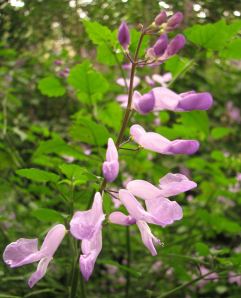 My Magic Cottage is completely enveloped in a mauve haze at the moment. The entire Plectranthus family is in full bloom.
My Magic Cottage is completely enveloped in a mauve haze at the moment. The entire Plectranthus family is in full bloom.
These gorgeous shrubs are an absolute riot in the shady areas of my garden and range from ground covers to over 2m high. They are the view over the top of my computer screen, from my verandah and almost hide my house from the neighbours – just the roof sticks out about them! In the Bronner’s driveway, behind my house, I planted them with pineapple sage so the contrast of purple and red is absolutely spectacular. One of my favourite colour combinations.
The most common and really easy to grow Plectranthus‘ are ecklonii and fructicosus– the colours range from dark purple to pale lilac, pink and even white. They grow so easily – just stick a stalk in the ground and they sprout in no time. The fragrant foliage is attractive for much of the year with many of the leaves having contrasting purple undersides or prominent veins. Being forest edge plants, they enjoy well composted soils, a thick layer of mulch and are ideally suited to growing in the shade of trees. They are pretty drought resistant and although they are frost tender, plants affected by frost can be cut back at the end of winter. Actually, most make better, more attractive shrubs if they are pruned at the end of winter before the new growth begins in spring.
 Another favourite is Plectranthus saccutus – a much smaller shrub which has blueish-mauve flowers (and sometimes white). It is commonly known as ‘stoep jacaranda’ which describes the colour perfectly. As Ernst van Jaarsveld says in his wonderful book on Plectranthus – they “turn shade to glade”. They really do.
Another favourite is Plectranthus saccutus – a much smaller shrub which has blueish-mauve flowers (and sometimes white). It is commonly known as ‘stoep jacaranda’ which describes the colour perfectly. As Ernst van Jaarsveld says in his wonderful book on Plectranthus – they “turn shade to glade”. They really do.
The more compact Plectranthus zuluensis thrives in the semi shade around my bottom lawn. It flowers for much of the year and seems to do well with little water. There are other sun loving varieties which I see in the grassland, but which I couldn’t grow in my shady garden.
Groundcovers abound as well, I have eleganthulus in a pot (which was first collected in 1903 in the Karkloof), laxiflorus (citronella-like aroma) under the yellowwood tree  and ciliatus and verticiliatus along my paths. I adore the tiny dark blue Plectranthus dolichopodus which grows in the forest understory. Along the forest edges, right now, the white flowers of the tall annual Plectranthus grallatus, are beginning to fade.
and ciliatus and verticiliatus along my paths. I adore the tiny dark blue Plectranthus dolichopodus which grows in the forest understory. Along the forest edges, right now, the white flowers of the tall annual Plectranthus grallatus, are beginning to fade.
In my world, Plectranthus herald the beginning of Autumn. Once the rain has stopped the days are quite magnificent. Bright and hot but with cool relief in the early mornings and evenings – a delicious chill about the ankles. There is enough residual dampness to keep the garden green but no more mud. I have my lunch outdoors everyday, watching butterflies and bees buzzing about. Plectranthus are pollinated by long-tongued flies, interesting creatures to watch going  about their business.
about their business.
There are also the beautiful sunrises which are so much easier to enjoy at 6am with a cup of tea (and a wander down the road), than at 4.30 or whatever they are in summer. It is a real pleasure to watch my bedroom walls turn pink as I wake up.
Autumn is my favourite season, in case you hadn’t guessed.
